The S&P 500 officially entered into a bear market on Monday, and to most people that sounds really scary because bear markets have been known to last for years at times and for prices to go a lot lower.
So what's the right thing to do?
Is it smart to sell now before prices get a lot lower, and to hopefully buy our stocks back when they get cheaper?
Table Of Contents
You're Better Off Staying In The Market Than Timing It
Performance Differences During The '08-'09 Crisis
What The Greatest Investors Do During Bear Markets
11 Bear Markets In 72 Years
So let's learn a lot more about bear markets.
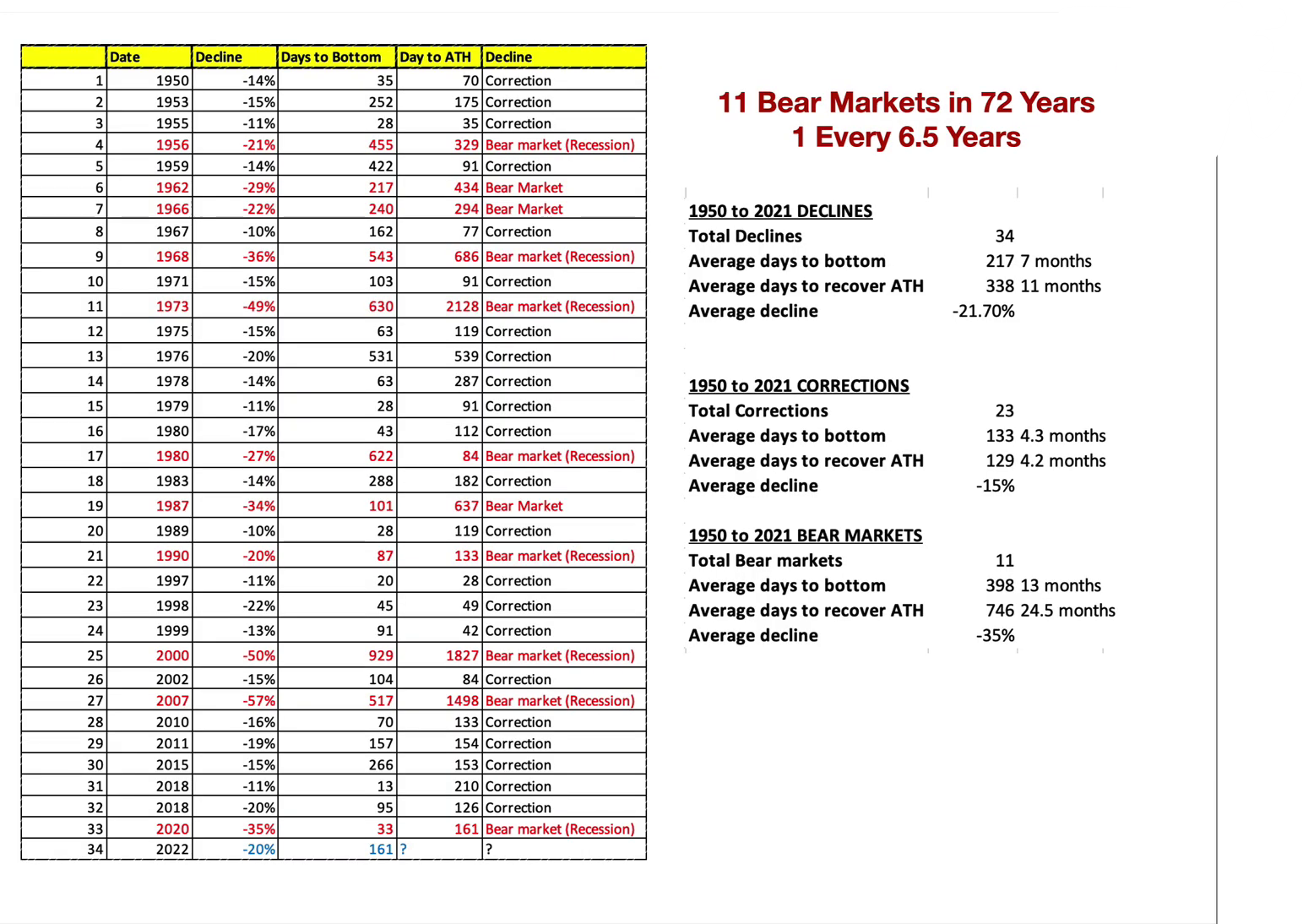
If you take a look at the last 72 years, this image above is from 1950 to where we are today. They've been altogether 11 bear markets which are marked out in red. As you can see, 1956, 1962, 1966, 1968, 1973, and so on and so forth.
So, with 11 bear markets in 72 years, that gives us an average of 1 bear market every 6.5 years. Of course, it doesn't appear every 6.5 years. In certain periods they appear more often, in certain periods, they don't appear for a number of years. In fact, the last bear market we had was in 2020, just 2 years ago, and now we're in another bear market, right?
So it's kind of coming all at once right now.
But over the long run, bear markets are not that common. If you take a look at the bear markets, they could be very short bear markets that decline about 20% or 30%, and we've got major bear markets during major recessions.
Most recently was the subprime mortgage crisis, where the markets dropped 57%, and the Dot-Com bust was like 20 years ago, it dropped 50%.
But if you average all the bear markets, the average decline of all the bear markets is about 35%.
So currently the S&P 500 is down 22%. The Nasdaq is down 33%.
So people would say, "Wow, we could go down a lot more".
Intuitively, and emotionally a lot of people feel that "Hey shouldn't I get out now before it drops another 10%, and maybe I could buy back at a lower price?", especially looking back at the two major crashes the Dot-Com Crash and the Great Financial Crisis, it would have made sense to get out and get back in at much lower prices.
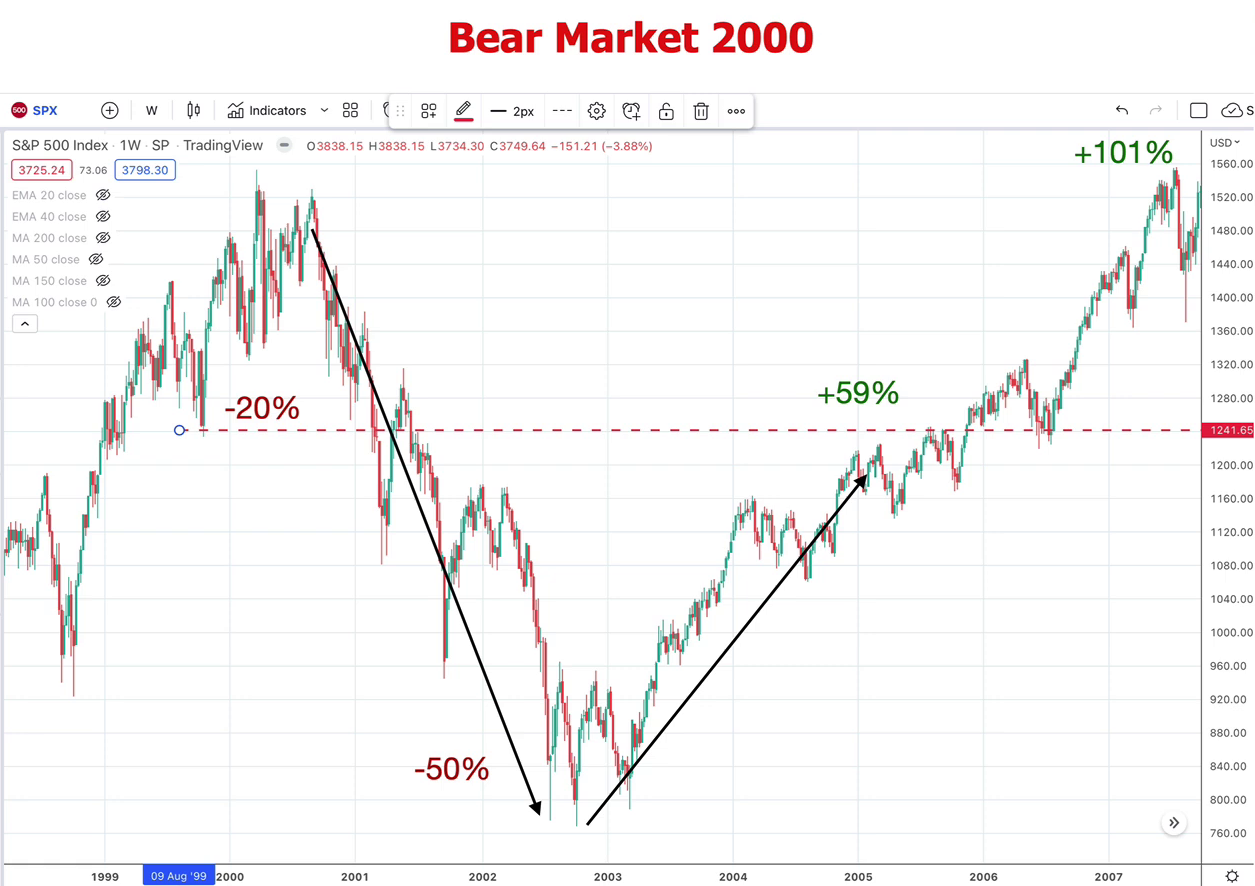
For example, if you take a look at the Dot-com crash, you can see that the S&P fell 50% from the peak to the bottom.
So the moment people realize "Okay it's a bear market we closed below 20%, get out. Avoid the other 30% drop, and I could get back in at a much lower price."
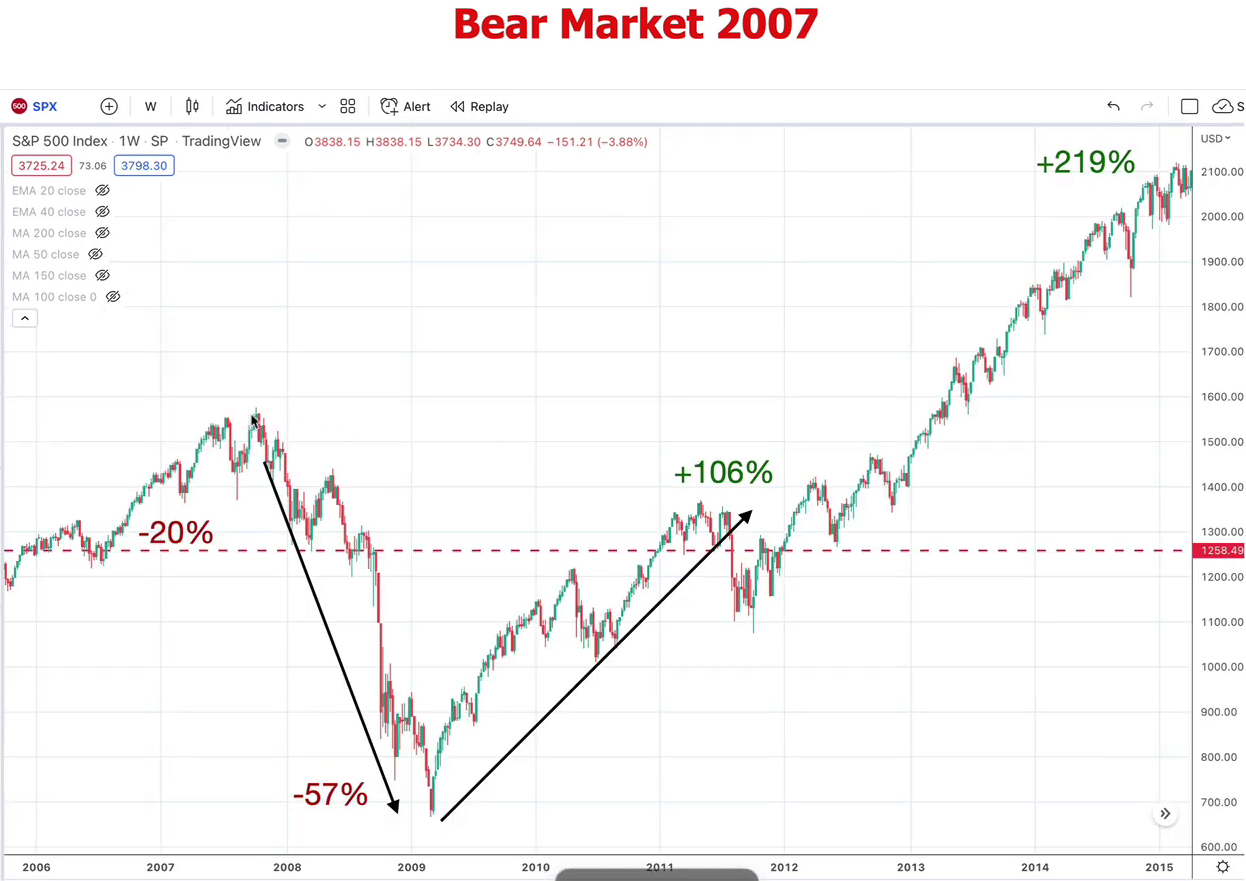
Made sense if you look at it this way. Same thing with the subprime mortgage crisis, where the S&P fell from the peak to the trough, 57%. If you looked back at that time you'd say:
"Hey it would have been good to get out at 20%, and I could get back in a lot cheaper!"
In fact, those of you who have taken my courses know that I teach you to identify the major changes in trends using moving averages.
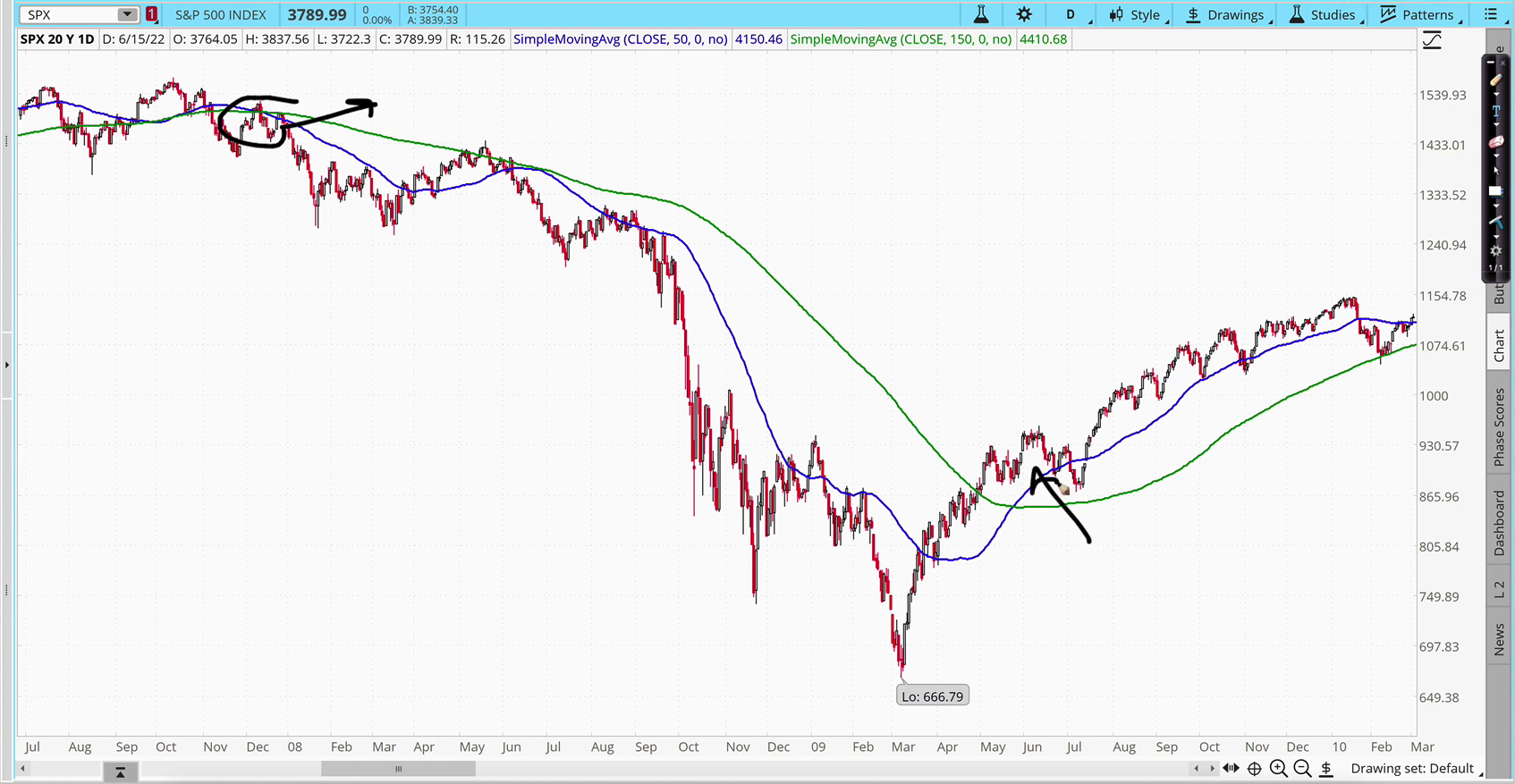
For example back in 2007, when the 50 moving average (blue line) crossed below the 150 moving average (green line), that signaled a change in the long-term trend to a downtrend, and that would have been an exit signal — avoiding the rest of the crash, and then getting back into the markets when the 50MA crosses back above the 150MA, getting you back into the markets.
This technique would have worked really well during the Dot-com crash as well.
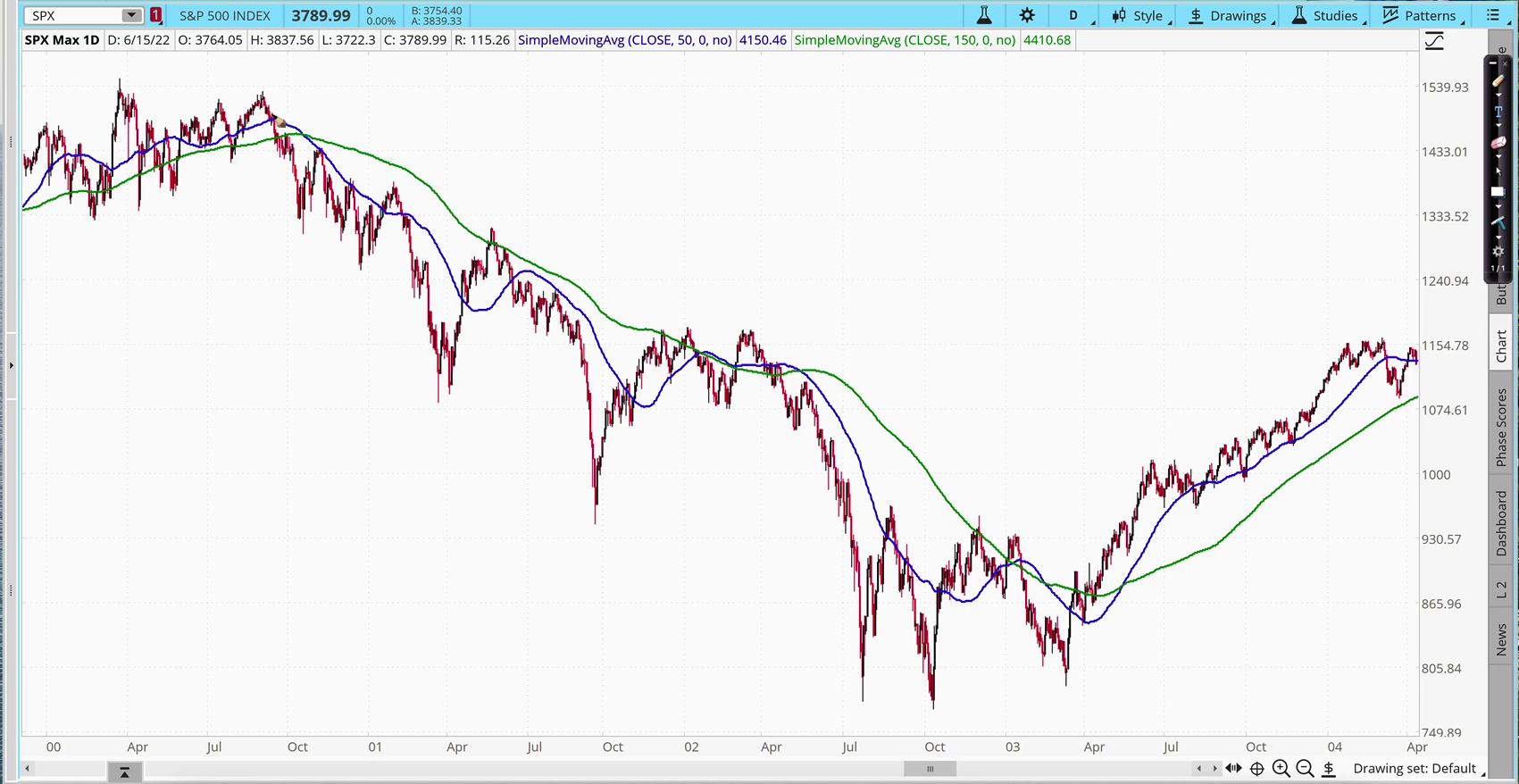
Again 50MA crossing below the 150MA. Once the moving averages are sloped down, you get out and you'd avoid the rest of the major downtrend. Some parts might look like a change in a trend, but they're not trend changes as the moving averages are still sloping down.
You want to wait for the moving averages to be sloping up, for the 50MA to cross back above the 150MA to get back in the markets, and then catch the new uptrend.
So, this technique works really well for certain bear markets like the Dot-com crash & the financial crisis, where it was a protracted long recession and a long bear market.
But here's the thing — this technique doesn't work all the time.
It's because these bear markets are the exception and not the norm. In fact, most of the time, bear markets don't last that long. They don't drop 50%-57%, that's really, really rare.
In the majority of other bear markets, you'll find that they dropped so fast but went up so fast that if you wanted to get out, very often you would not be able to get in fast enough, and by the time you want to get in, markets would have been all-time high, and you would have missed the run-up.
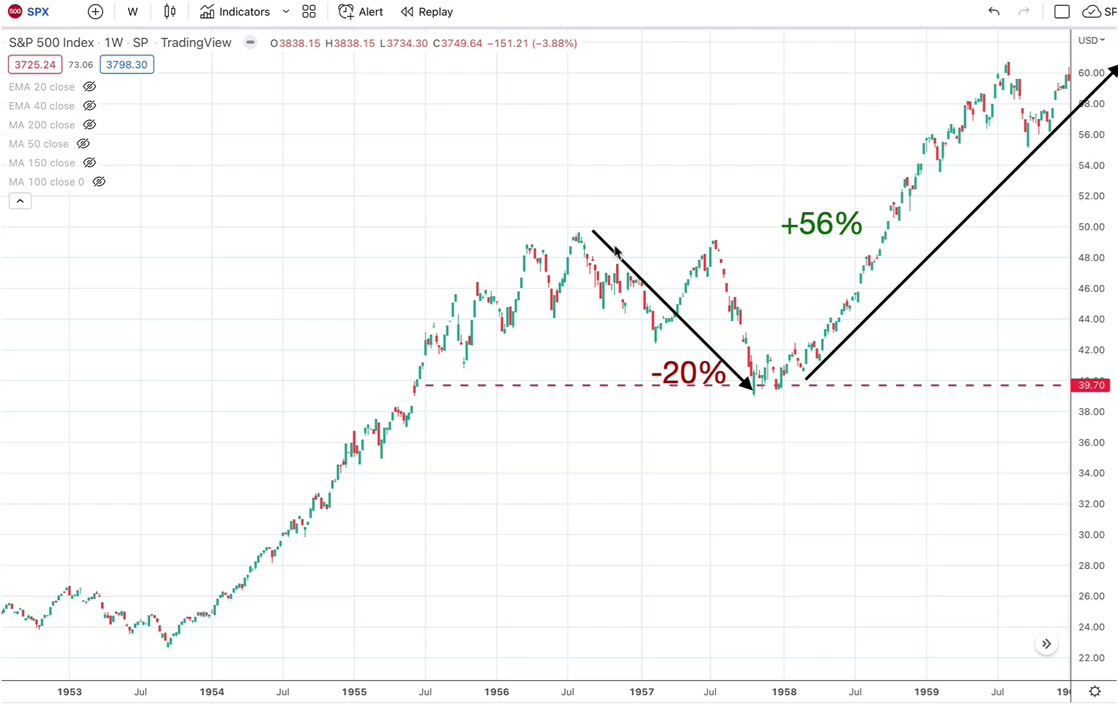
For example, you look at 1956. What happened during that time?
The moment the market dropped below 20% and people are thinking "It's a bear market! Oh my god let's get out!" and the moment they got out, what would have happened?
The market would have gone 56% and they would have missed those gains.
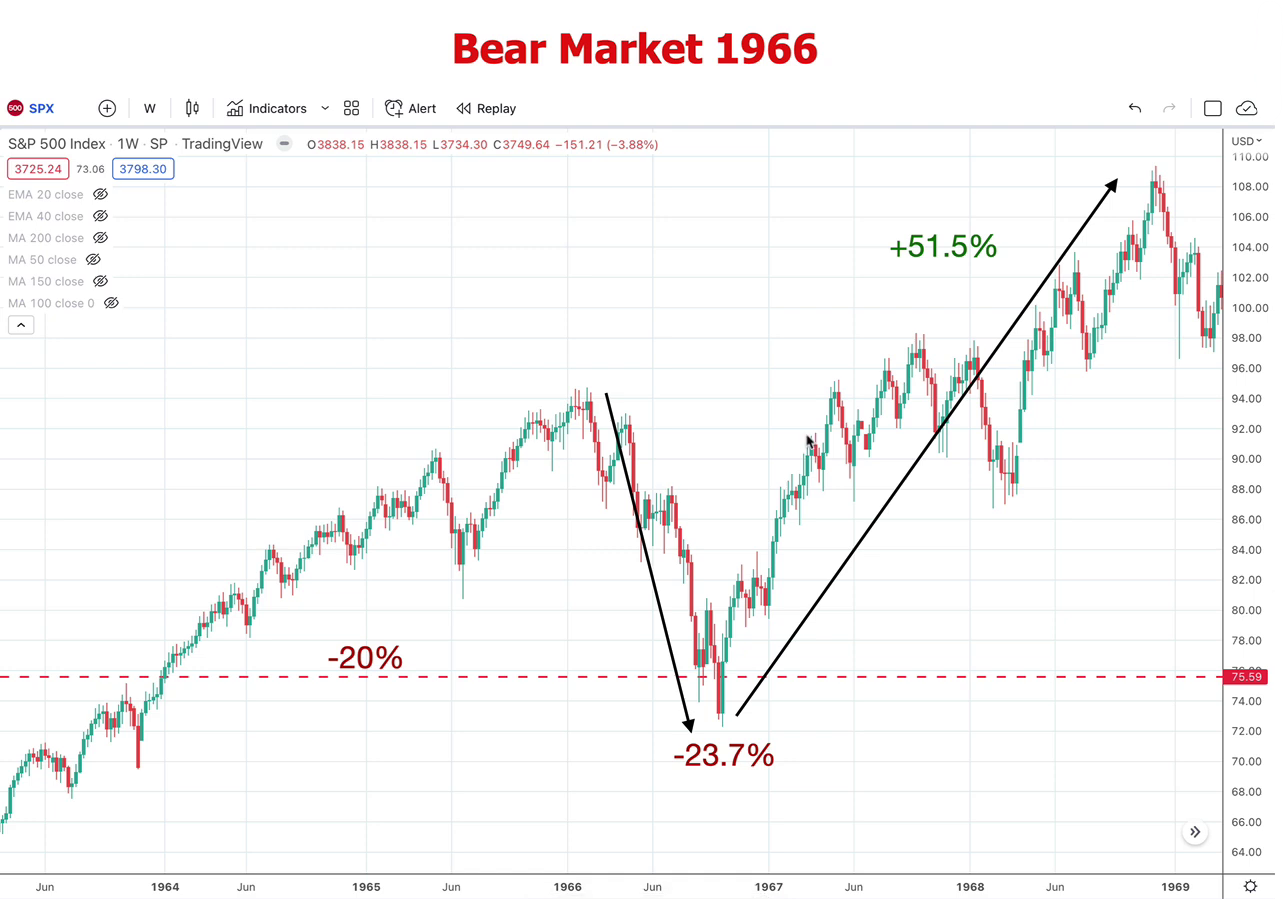
Another example would be back in 1966. The market dropped and again, the dotted line represents the 20% level. So when the market drops below that 20% level, people panic and think it's going to get worse.
Sure, it drops a bit more to 23% but then, BOOM!
It goes up 51. 5%.
So that's what happens to a lot of people. They get out the moment as a bear market, and they don't get a chance to get back in, and the moment they want to get back in, the market runs up so fast that they missed the ride up.
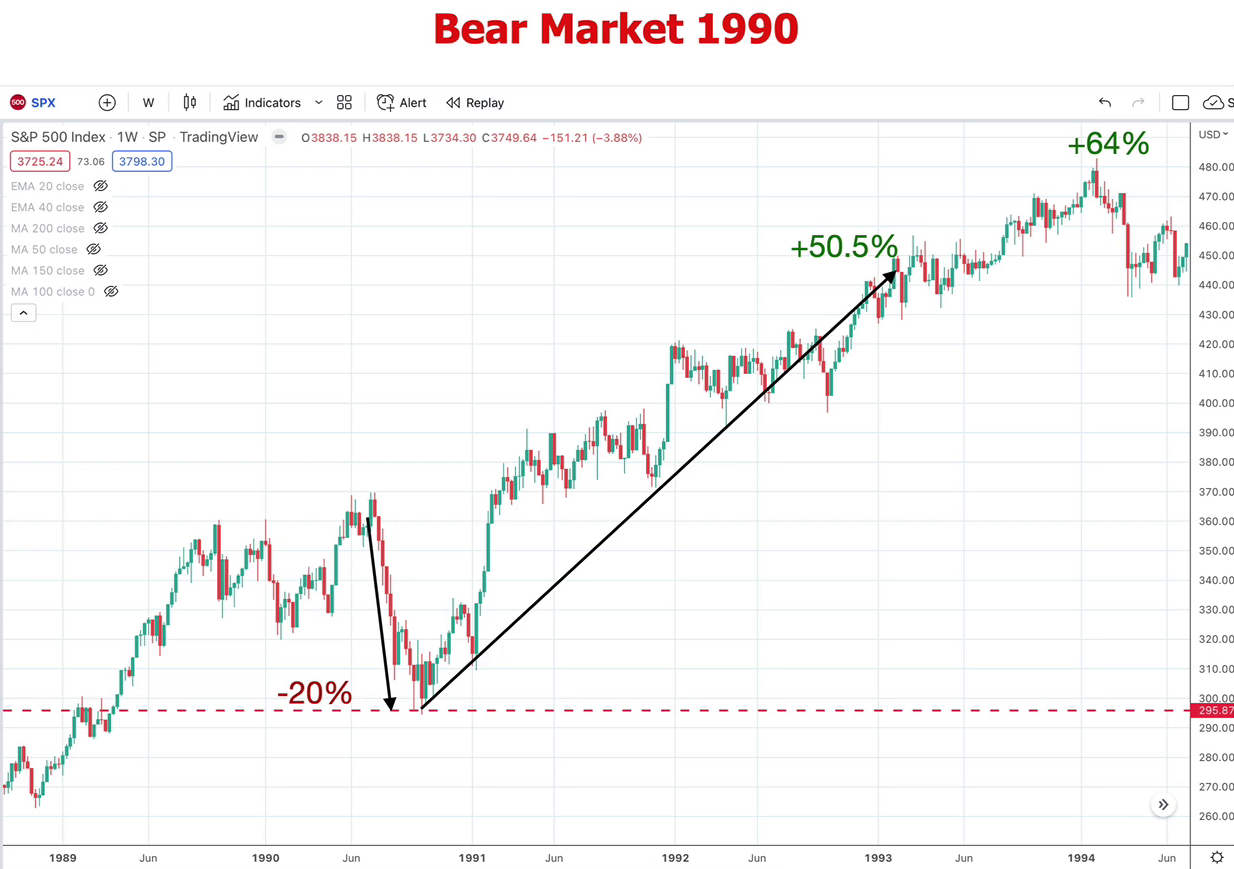
Same thing in 1990. The market dropped 20% again, declared a bear market, people panicked and got out, the next thing they know, the market was up 50% and 64%.
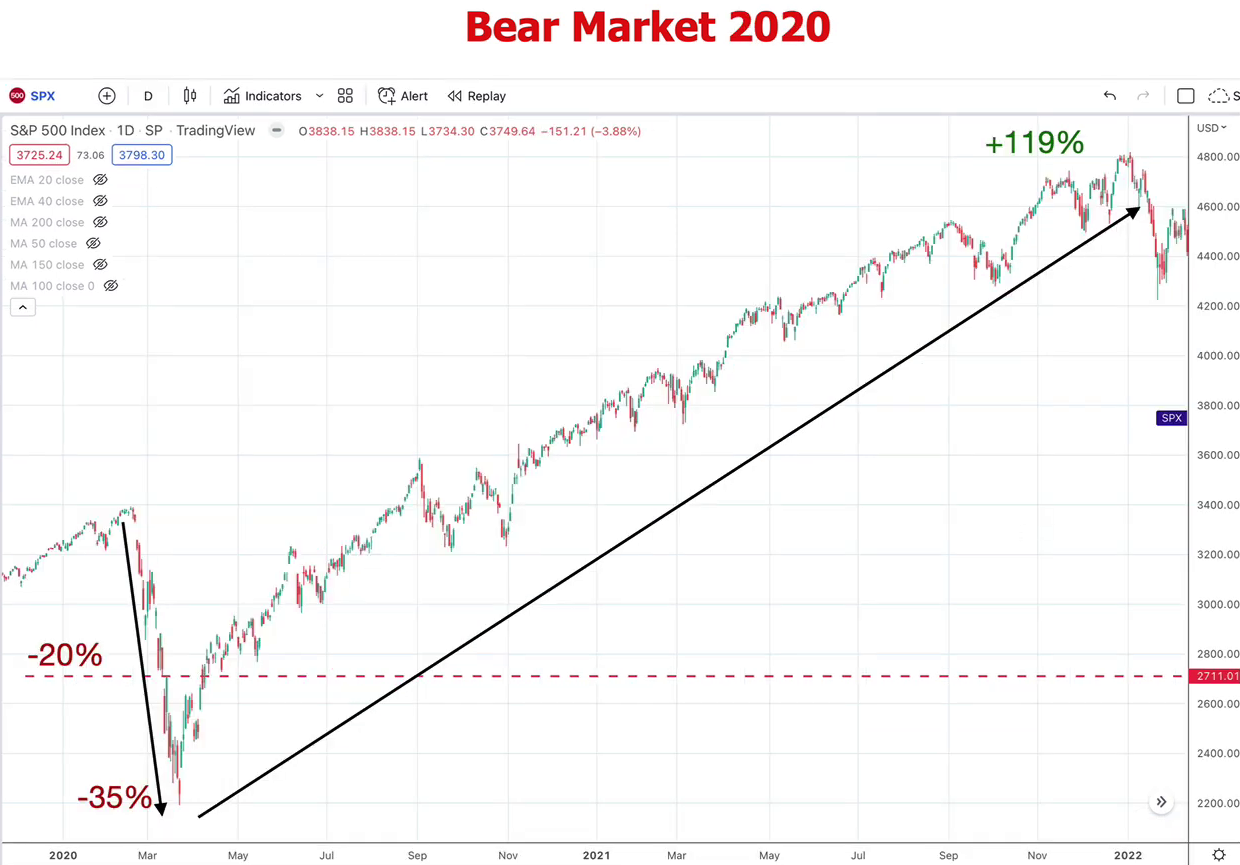
Most recently two years ago was the COVID pandemic and again that went down and went up so fast that a lot of people who
got out and never got back in.
They lost so much money from the crash but they never got a chance to be there when the market made it all back. 2 years ago the market dropped 35%, and again a lot of people panicked the moment it dropped 20%, and they sold.
They say "I'll get in lower", but before they could get in, the next thing they knew, the market bounced up and went up 119%.
So in many of these cases, you find that even if you used moving averages to get out on the downtrend to get back in on the uptrend, you'd end up getting back in at much higher prices or not even getting in at all.

subscribe to our newsletter today!
Get first dibs on our latest investing & trading content every week FOR FREE!
*Your email address will not be forwarded to any third party. We respect your privacy.
You're Better Off Staying In The Market Than Timing It
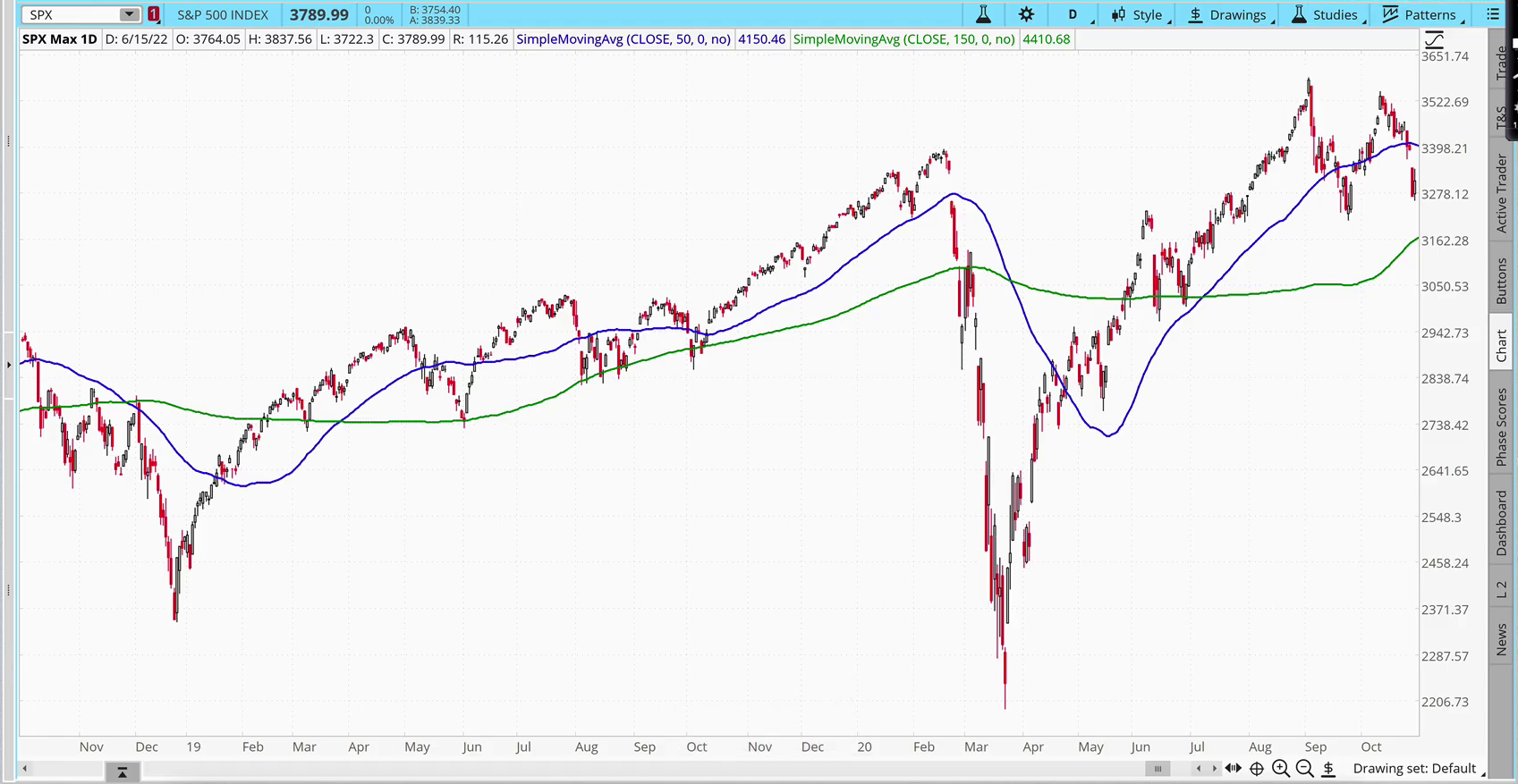
If you take a look at the daily charts, this was the COVID crash. What happened was that it dropped by 20%, and people panicked and cut their losses.
By the time they waited for the trend to reverse back up — for the 50MA to cross back above the 150MA — they would have gotten back in much higher than they got out.
So they miss out on those gains by trying to get in and get out, and worse still, some people didn't even manage to get back in, and the market went up without them.
So, they ended up losing 20% or 25% while never ever getting it back.
Shortly before that, during the trade war crash, the same thing.
The market dropped exactly 20% there. People panicked and sold, and never got back in because the market went up too fast or they waited for the uptrend signal. If they got back in on the uptrend, they would have missed a huge amount of gains as well.
So, here's the bottom line.
A lot of people think that if it's the Financial Crisis or the Dot-com crash, it made sense to get out and get back in at much lower prices. That's true, but those bear markets are very, very rare.
The majority of bear markets are like these bear markets above, where the market goes down and goes up so fast that if you attempt to get out, oftentimes, you can't get in fast enough or you get in at a much higher price, or you don't even get a chance to get in at all and you end up losing money and not being there when the market returns everything back to you.
This is why research has shown time and again that over the run, you're better off staying in the market — holding on to good companies than trying to get in and out.
So, for example, back again in 2020, what happened?
When the market dropped and the moment it dropped below 20%, people panicked and got out.
They aim to get back in at a lower price, but no one could ever know where's the bottom!
So the cost and the risk of getting out and not being there when the market gains everything back is a far greater risk than just holding it and seeing it go down temporarily.
You know that it's eventually going to bounce back up.
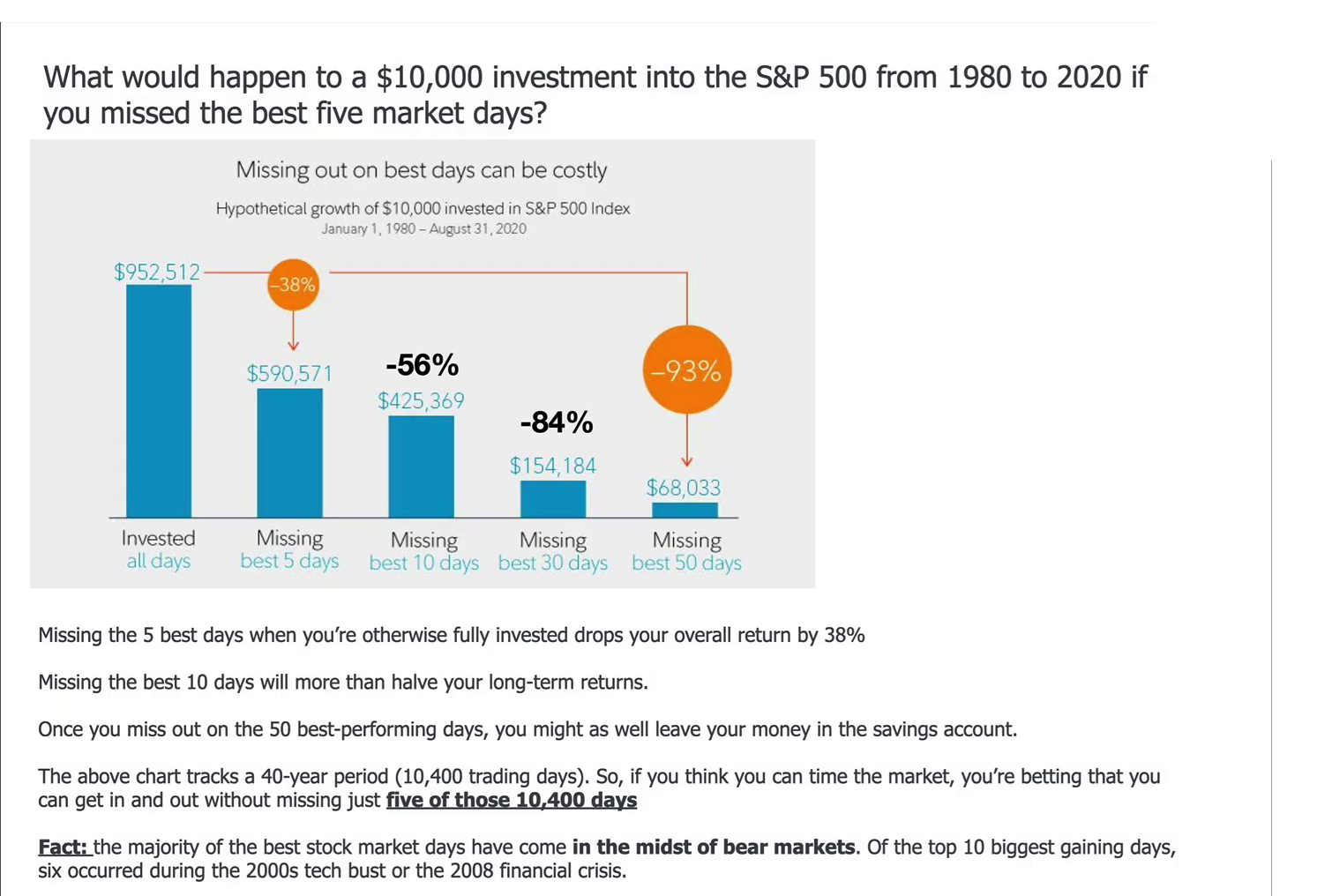
And that's why research has shown time and again that time in the markets is more important than timing the
markets.
Because if you time the markets and you get it wrong (and it's really easy to get it wrong), you're going to be much better off just holding good companies or holding the index.
Trying to jump in and out of the markets will end up worse for most people. I'm
sure you've seen this research before, but I'm going to reinforce it once again.
So, what would have happened to a $10,000 investment in the S&P 500 if you just missed 5 days out of a 40-year investment?
So from 1980, if you invested in the markets to 2020, that's 40 years. Over that 40 years, its a total of 10,400 weekdays (or trading
days).
You can see that if you are fully invested in those 40 years, your $10k would have grown to about $952,512, about $1 million.
But out of those 40 years, if you happen to miss just 5 of the best days — of the best gaining days — at the end of the period, you
would have only $590,000. In other words, you would have 38% less returns than if you'd just stayed invested.
If you missed the best 10 days out of those 40 years, you would end up with only $425, 000 versus $952,512. In other words, you're down 56% less returns.
If you missed the best 30 days, you're down 84% from just holding it.
If you miss the best 50 days, you're down 93%, you might as well have just held cash.
So, what's the bottom line?
The bottom line is that if you think that you can time the market well, get in and get out, and beat just holding it, you're betting that you can get in and out without missing just five of those days out of 10,400 days. Good luck with that.
The majority of the best stock market days where the market had the biggest gains have come in the midst of bear markets. In fact, of the top 10 best gaining days, 6 of those days occurred during the 2000 Tech Bubble bust, and during the 2008 Financial Crisis.
Performance Differences During The '08-'09 Crisis
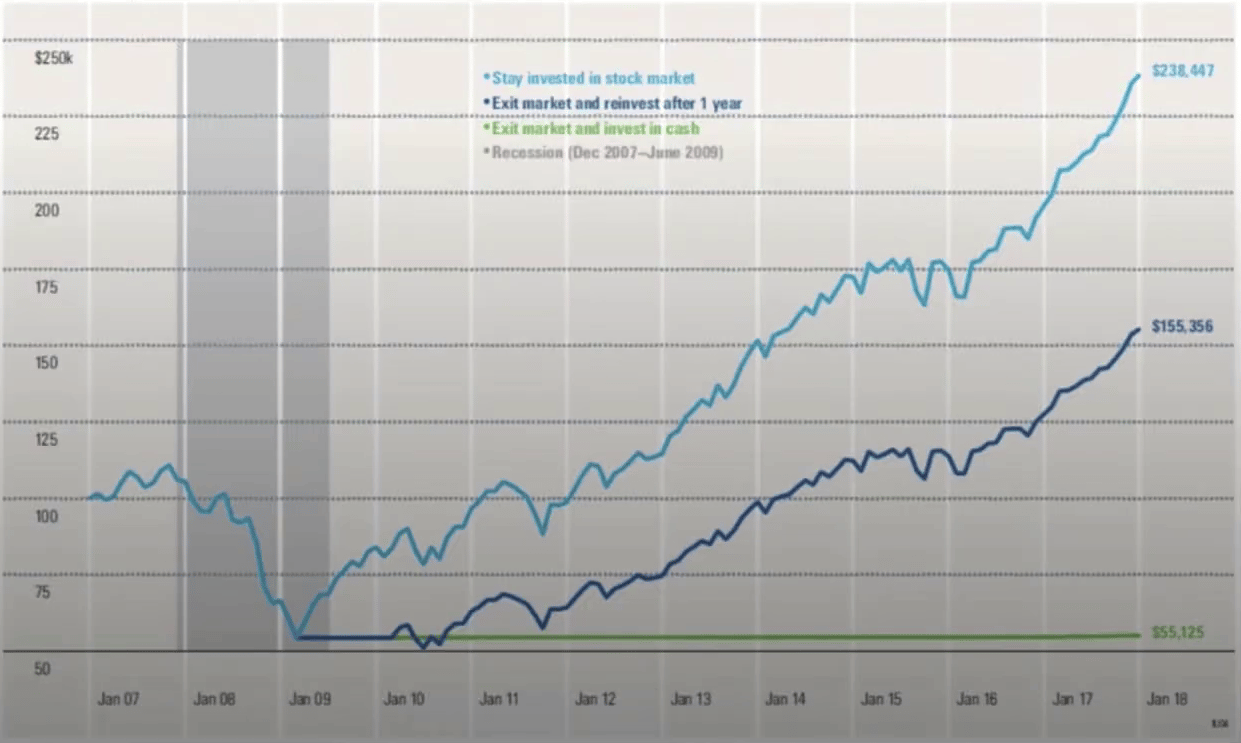
This is what happened to people during the Financial Crisis back in 2008-2009. You can see what happened to people who panicked and sold for cash during this crash. These people that stayed in cash would have gotten the least returns at the end (in green )which is about $55,000 right?
Those that got out of the market, and got back in after 1 year when the uptrend resumed, would have ended up with $155,000.
Those who just stayed the course, who just stayed in the markets without timing it, would have ended up with $238,000 at the end of 2018, which is 9 years later.
For the majority of people, I can tell you that if you get out during a bear market hoping to get back in cheaper, most people will regret it a year from now. I've seen it many times myself over the last 4 bear markets
What The Greatest Investors Do During Bear Markets
That's why if you take a look at the greatest investors of all time, whether it's Peter Lynch, Charlie Munger, or Warren Buffett, none of them got out during bear markets.
What did they do during bear markets?
They held on and they continued buying good companies at undervalued prices, averaging down their positions. That's what made them the richest people in the world, and like what Peter Lynch said many many times:
"Far more money has been lost by investors preparing for corrections, or trying to anticipate corrections than has been lost in corrections themselves."
Remember, if you're holding good companies and the price goes down, even if it drops 20% 30%, or 40% below your purchase price, you have not lost anything.
If you don't sell, you don't lose, provided they are good companies, because with good companies you know that the price will always bounce back eventually. Whether it's 3 months from now, 6 months from now, or 2 years from now, they will go back up eventually.
So, if you're not forced to sell and you don't sell, it ain't a loss. It's only a loss if you sell and there's no reason to sell unless you're forced to, right?
And if no one's forcing you to sell is, just hold on. It will go higher eventually.
Any Reason To Sell During Bear Markets?
So, is there any reason to sell stocks in a bear market?
The answer is yes. There are reasons. There are times when you need to sell stocks.
The 1st reason to sell stocks is only if you're holding stocks of lousy businesses.
Remember, a stock is a piece of a business. So, if the underlying business is a lousy business — it's losing money continously, and the intrinsic value of the business is declining — then you want to get out because these are stocks or companies that will never recover.
Their share price will never bounce back. The only reason the share price was high, eventually, was because of speculation hype, because of the easy money. Now that the easy money is over, there's no free money. These stocks are going to drop or have dropped, and they'll never come back.
So, you'd want to sell these stocks, take that money and immediately reallocate to stocks of great businesses.
So what's a great business?
A great business is one where consistently every single year, they are making more and more money, their profits are increasing, and they are generating higher and higher free cash flow.
So in other words, every year the value of the underlying business is actually increasing, the intrinsic value is rising and the share price is going down even though the is more valuable.
Why? Because the share price in the short-term is driven by fear, emotions, and speculation. And for these companies, you've got zero worries because if the companies are worth more and more every single year, you know the share price is down not for fundamental reasons.
The price is down purely for liquidity or technical reasons that eventually, once sentiment shifts, the price is going to go way back to its intrinsic value.
So companies like Microsoft, Alphabet, or Adobe, are companies where you've got zero worries.
Yeah, the share price goes down 20%, 30%, or 40% at times but the actual business is making more and more money every year. The business is becoming more and more valuable every year.
So, there's really no loss in these businesses. There are no worries in these businesses but again, if you hold companies that are losing money or have got no intrinsic value then you've gotta get out. You've gotta reallocate during times like these.
The 2nd reason to sell stocks is if you are over-leveraged.
Now, I keep telling my students;
Never borrow to invest money. Only invest with the money that you have. In fact, only invest with money that you don't need to use in the next few years.
So, with money that you need to use in the short term, DO NOT invest it in the markets. No, you gotta hold it in cash or in short-term bonds. Unfortunately, some people don't listen.
They borrow money to invest, and it's really scary because if the market drops & drops & drops, you're forced to sell, and you'd sell at the bottom, you're going to lose a lot of money. When the broker gives you a margin call you're forced to sell.
If you are over-leveraged, which means you have borrowed money to invest, I would get out if I were you, because if it keeps going down 20% or 30% more you are really screwed, OR if you need cash for an emergency, then you have to get out.
But if you don't need the cash, you're not over-leveraged, and you're holding good companies, it makes sense to hold onto it.
Now having said that if you do need to sell because it's a lousy stock or you need the cash, or you are over-leveraged, you must also know WHEN to sell.
In a bear market, prices don't drop in a straight line. It falls in a wave pattern, and it will always wave up for a while. Its kind of like the market teases you, makes you happy, kills you, teases you, kills you, teases you.
So, if you need to sell for any of these reasons, you'd want to sell during the rally. So, you wait for a rally, for a bounce up, a wave up, and you get out before the next wave down.
Now, of course, we don't know the exact top of a rally, so after you sell, it could, it could go a bit higher before plunging back down again.
What you never want to do is sell at the low of a downtrend. Most people make the mistake of panicking when the market drops and selling near the bottom.
The moment they get out, what happens?
It goes up and they go "SHIT!"
And they thought it's going up, and they get in again, once they get in again, the market goes down again.
So remember, always sell at the high. Always wait for a high point to get out if you need to get out for these reasons. But if you don't need to get out, hold the bastards, okay?
Hold the good companies. And not only should you hold, but you should continue buying slowly, alright?
Again, I'm not giving you specific advice but I'm saying that as an investor, I continue buying stocks of good companies.
Now, people say "But Adam, what if I run out of cash? I don't have unlimited funds."
If you tell me that you've run out of cash, that you don't have more funds, then you're not following the 1st principle of wealth creation.
The first principle in investing is; You should never put all your money in at once, never.
Investing is not a sprint. It's a marathon that lasts for years and years and years. So investing is something you do regularly every month, every quarter. And the 1st principle is that if you want to build wealth, you have to always spend less than you earn every single month.
Whatever you earn spend less than that, save at least 10% or 20% of your salary every month every quarter so you always have some savings every month or every quarter, and you slowly put that to work in the markets.
So you should always have surplus cash every single month or quarter and if you don't do your best to reduce your expenses. Do your best to live below your means.
When To Start Buying Shares
Another common question I get would be, "When do I start adding shares of stocks of good companies? What if I buy, then it goes lower?"
Remember, you can never catch the absolute bottom. No one knows the absolute bottom. Now, of course, one thing could do is to only buy when there's a confirmed new uptrend. But the trouble is that by the time that happens, you tend to get in at a much higher price.
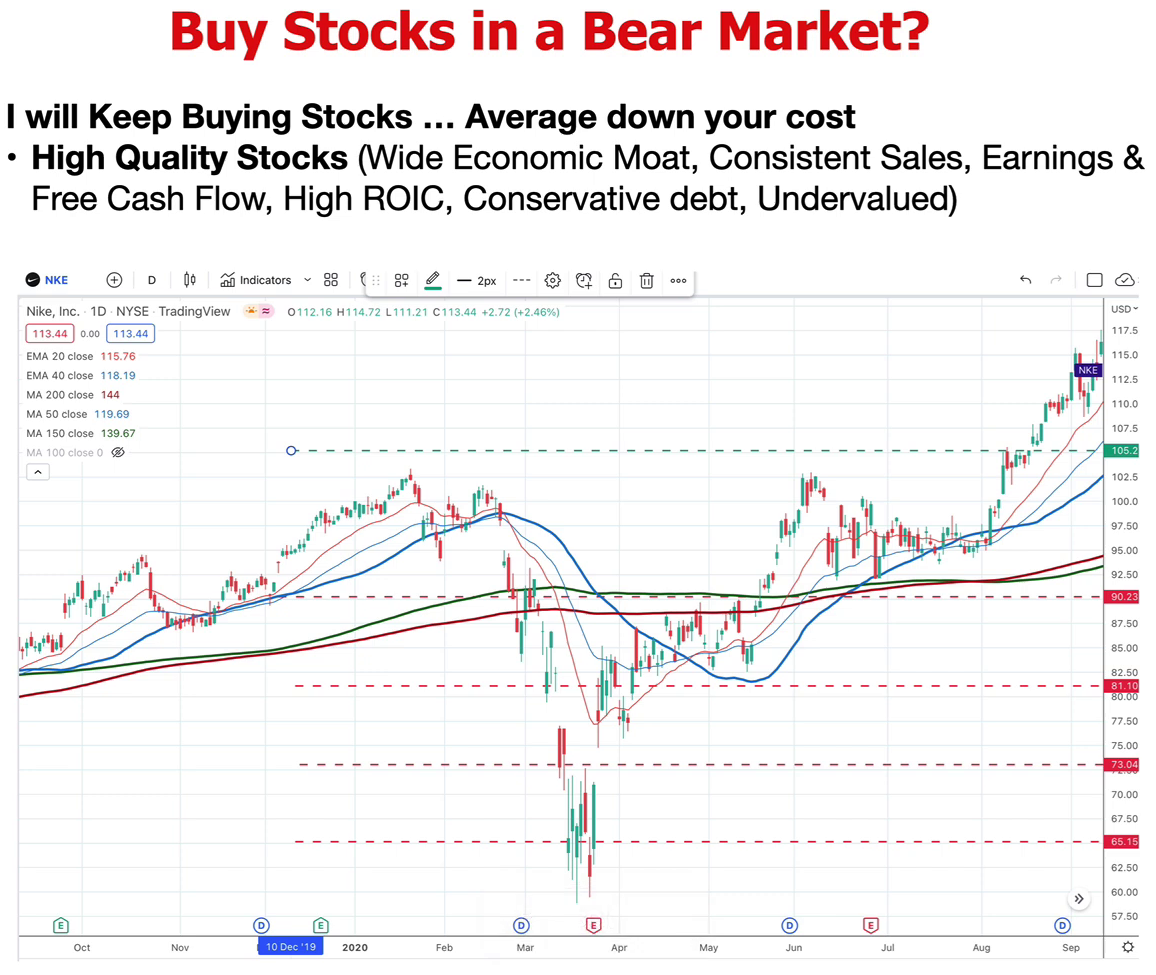
For example, take a look at Nike. This was during the bear market of 2020 when Nike dropped all the way down.
It dropped down about 35% or more, and then it went all the way back up as usual because again, Nike is a great company.
If you waited for a change in trend, for the 50MA to cross back above the 150MA or for the price to get back above the 200MA, sure, you would have missed out on a lot of gains. You could have gotten in at a much better price.
So the strategy that I use is really simple.
I buy in tranches; which means I don't buy all at once. I get in one tranche at a time. For example, I buy 1/4 of what I want to buy, another 1/4 of what I want to buy another time — I slowly average in my position.
The first time you enter must be when it's already undervalued. You have to learn to calculate and know the intrinsic value of every stock that you own, and the intrinsic value must be rising every year. It must be a good business that's making more and more money right.
Take a look at Nike.
At that time, the intrinsic value was $105 per share — that's the true value of the shares. You could have entered the first position, for example, at $90 when it was 15% undervalued.
So you always want to buy when it's undervalued to get a margin of safety.
So once you enter the first time, when's the next time you could enter?
A rough rule of thumb would be to enter when it drops another 10%, so if it drops another 10% to $81, you buy another 1/4 position, and if it drops another 10%, you just add another 1/4 position.
You add the last 1/4 position until you've got a full position.
Did it drop even more than that?
Yes, it did, but again you don't know the absolute bottom. But sure enough, if it's a good company, eventually it's going to go up and you're going to have a great gain, and by adding in stages your average cost will give you a pretty good return.
You don't have to buy at the absolute bottom.
Bear Markets Never Last
Finally, remember that bear markets never last.
A bear market is kind of like winter. Winter never lasts. Winter will always end, and what follows winter?
Summer! So don't fret during winter; don't just stay in your house. Go out skiing, build a snowman, right? Enjoy winter, because after winter is summer, that's when things will boom again.
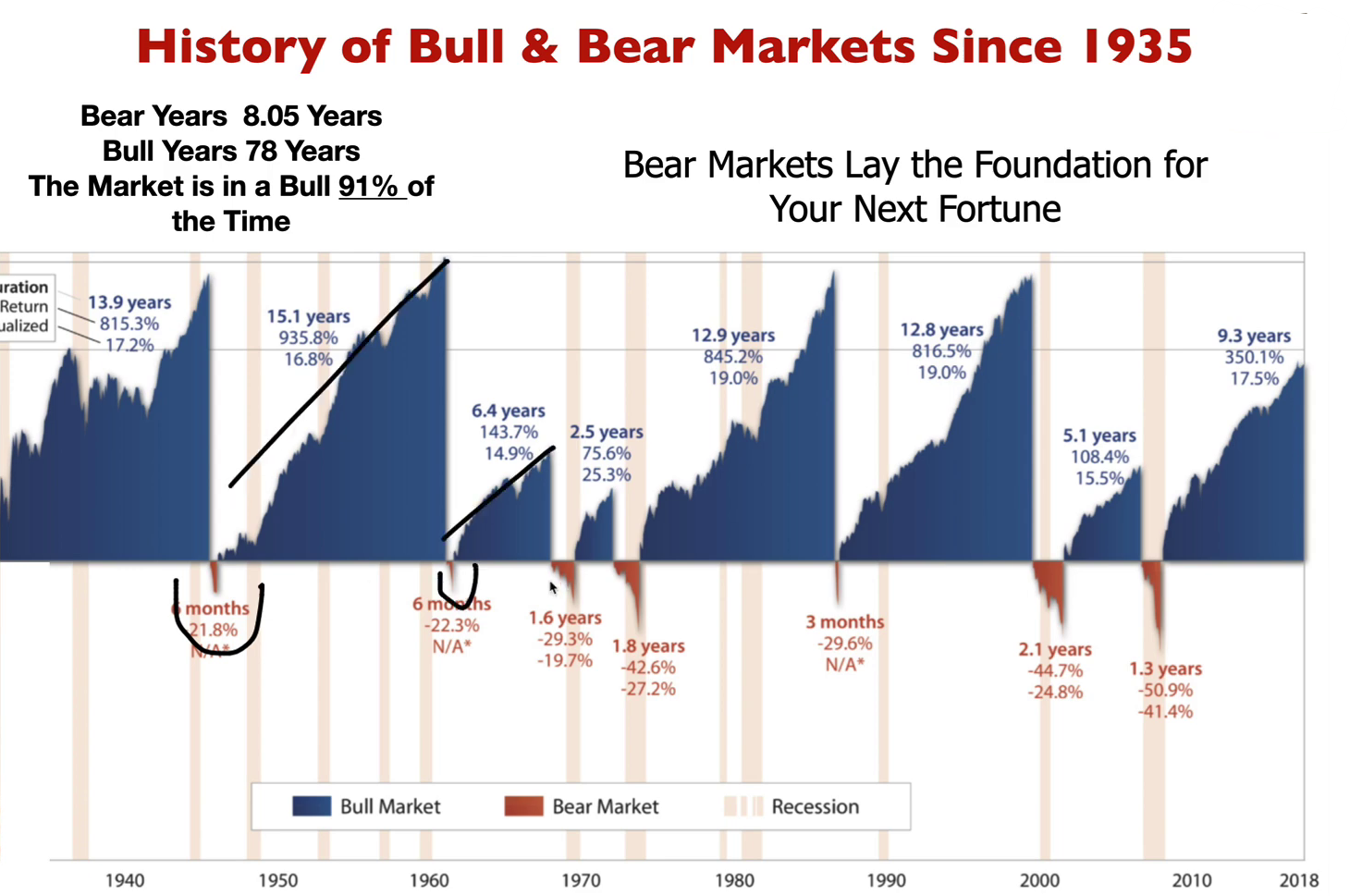
Same thing with bear markets; they don't last. After every bear market, there'll be a bull market. This has repeated since time memorial, since the beginning of the markets, and every bull market is always a lot bigger in terms of gains than the bear market.
So the bull markets are kind of like the reward that you get for going through the short-term emotional pain of a bear market.
The worst thing that you can do is to suffer the pain of the bear market but not be there to receive the rewards of the bull market. Look at all the 11 bear markets in the last 70 years — it always paid to stay the course, stick to your investment plan, and not freak out.
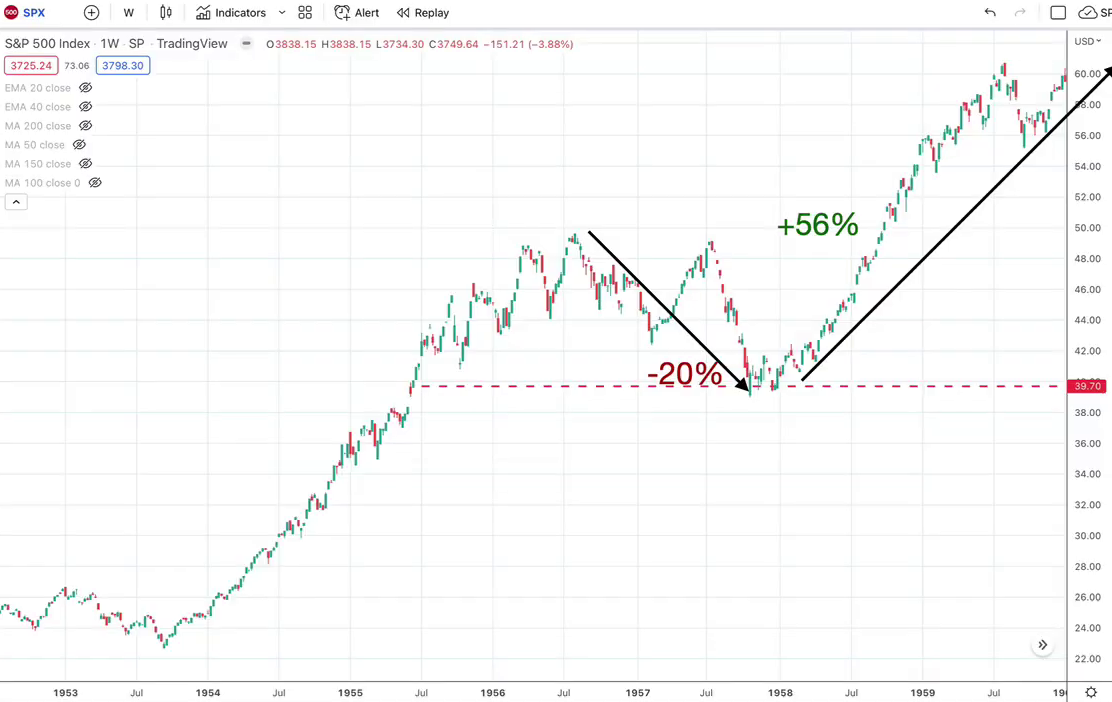
Let's start with 1956.
The market went down 20% but went up 56%.
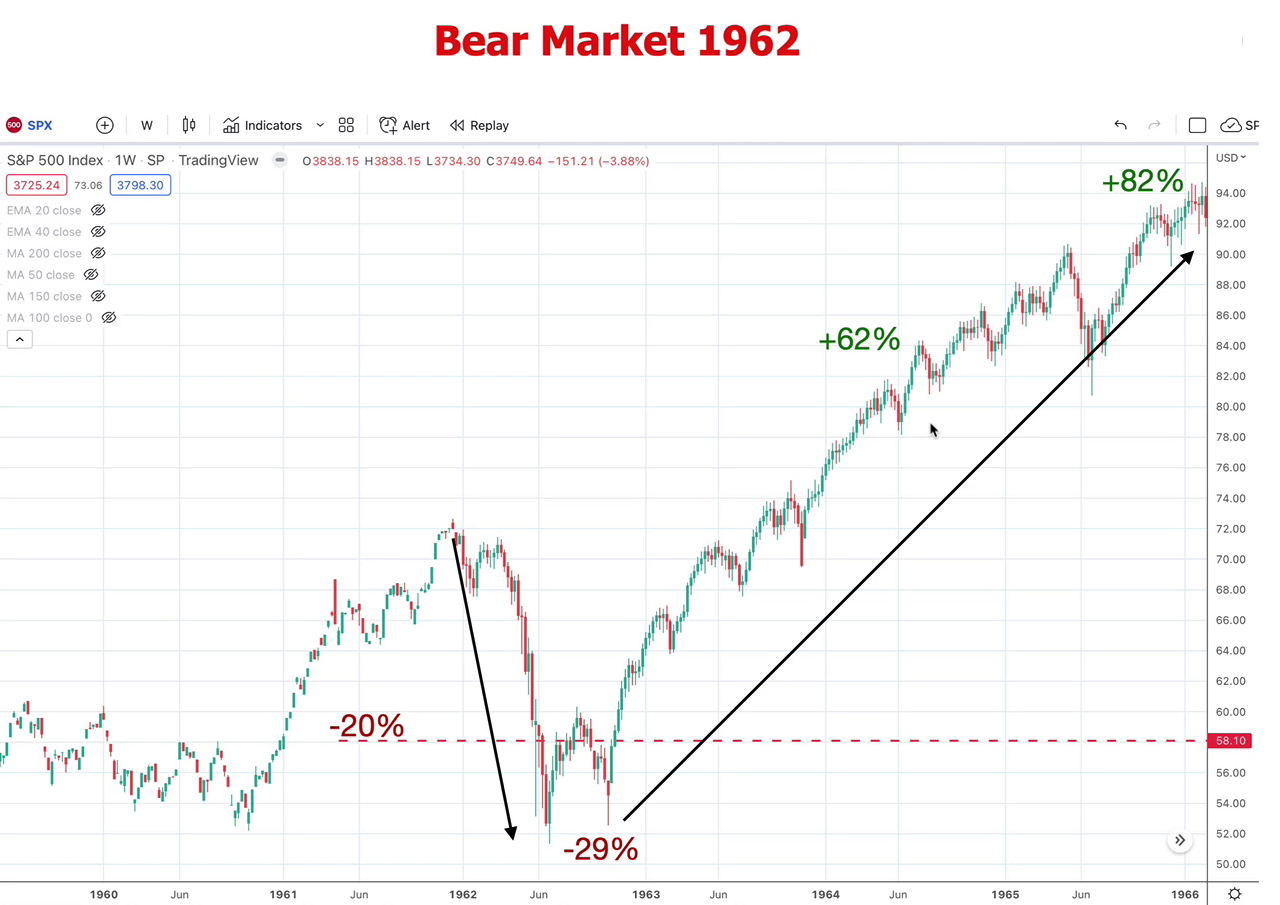
1962, the market went down 29% and went up 62%, then following that, 82%
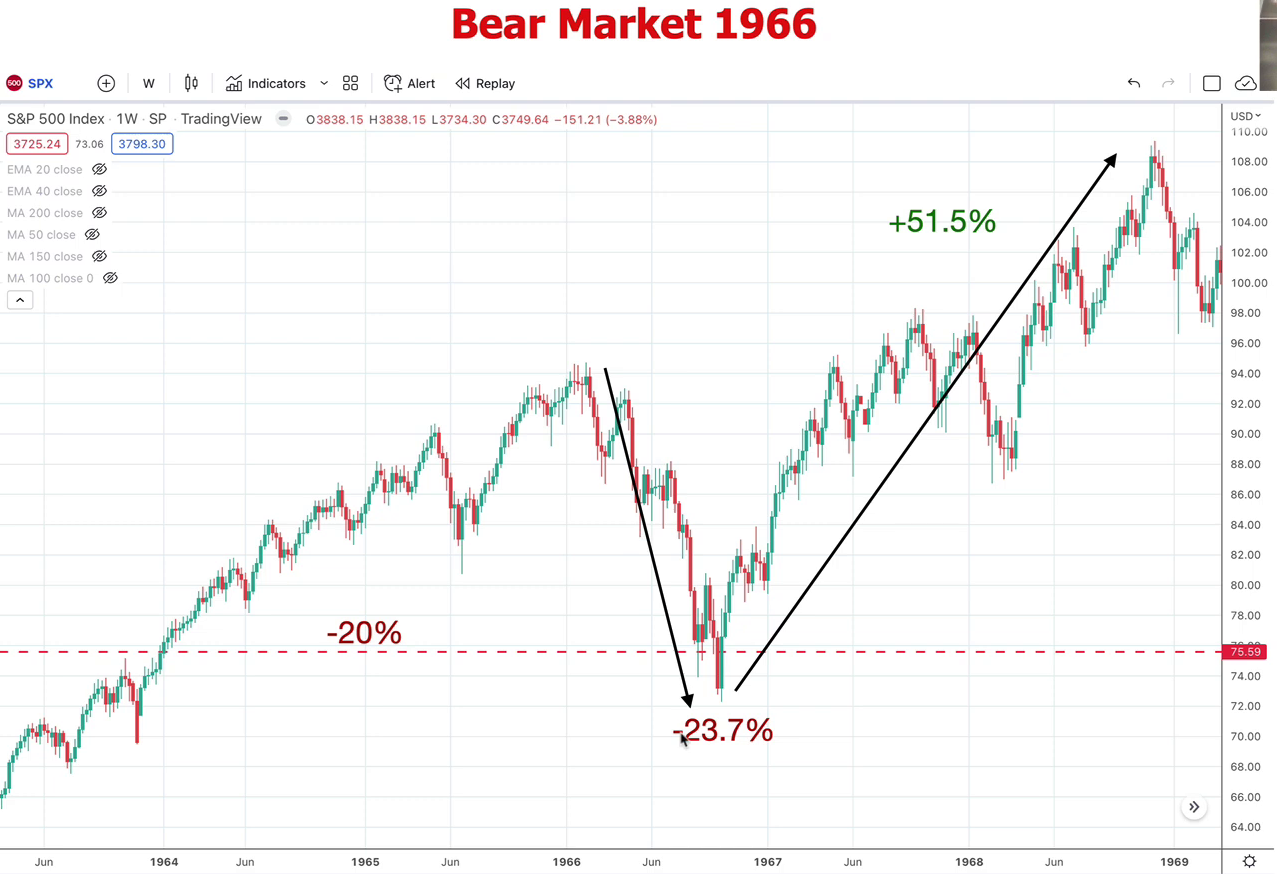
1966, the market went down 23% then went up 51. 5%.
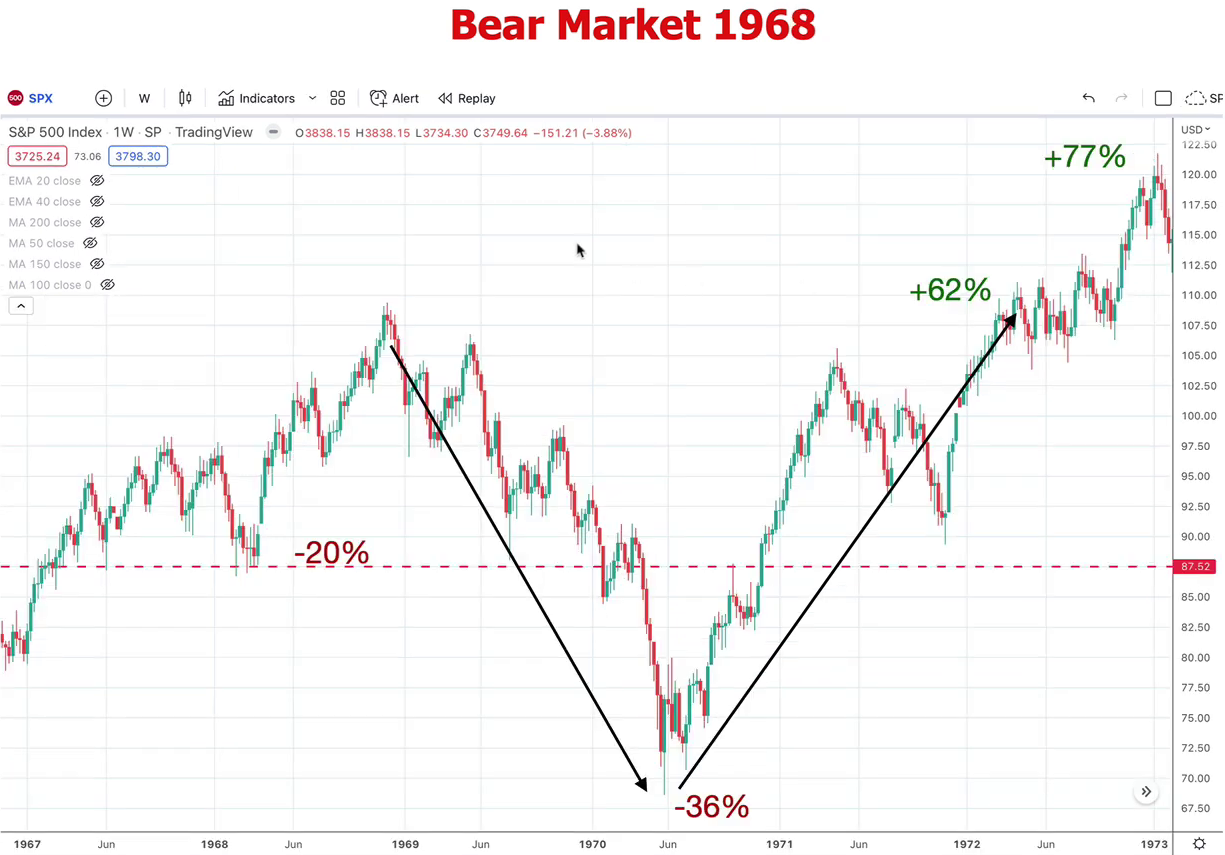
1968, the market went down 36% then went up 62%, and then 77%, and so on and so forth.
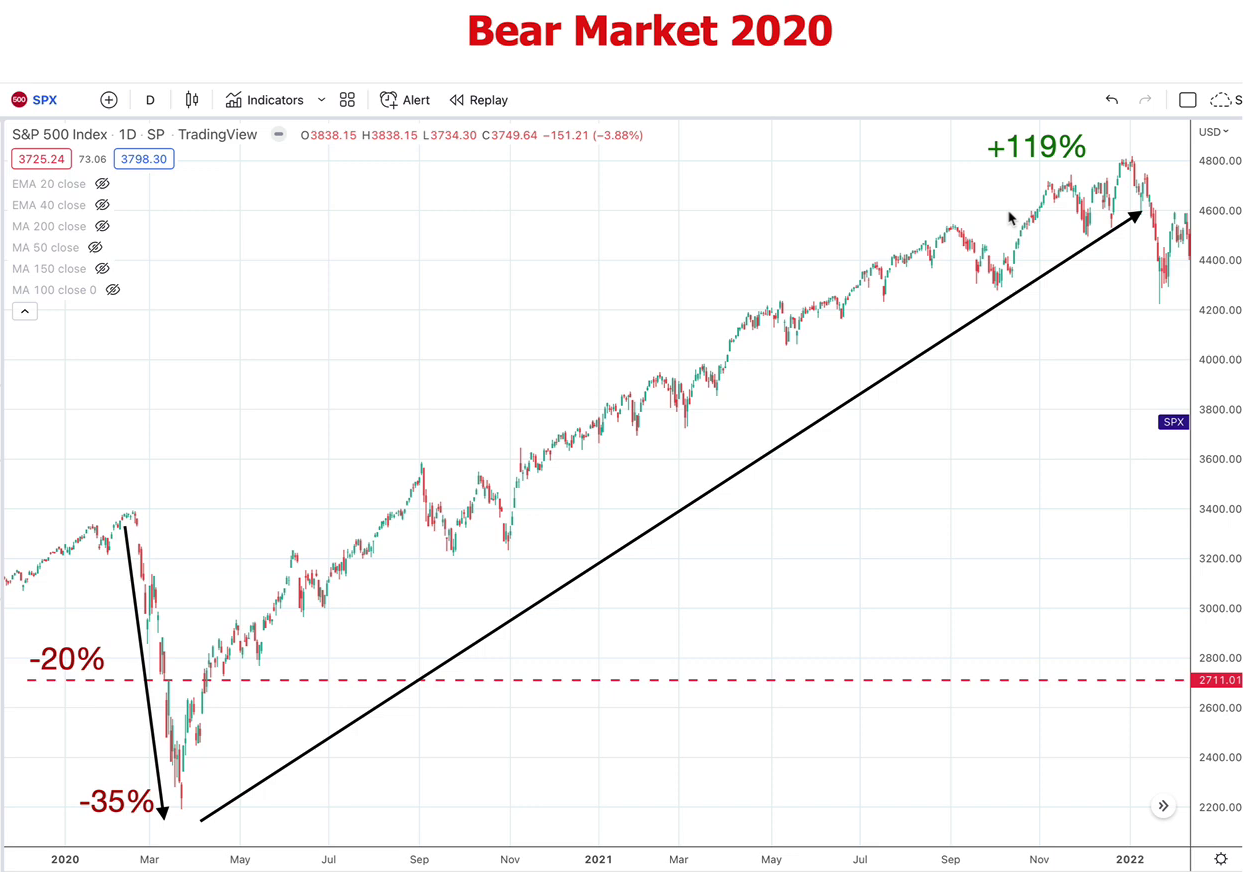
Of course in the last bear market, the market dropped 35% and went up 119%.
So we are in the 12th bear market of the last 70 years. No one knows exactly how it's going to turn out, but what I can tell
you is this;
If you stay the course, whatever is a short-term down is going to be a lot higher when it goes up. So be there when it happens. It tends to reverse at the time when most people least expect it.
So, I'll see you on the other side. Take care, stay safe, and may the markets be with you.

subscribe to our newsletter today!
Get first dibs on our latest investing & trading content every week FOR FREE!
*Your email address will not be forwarded to any third party. We respect your privacy.

.png)
.png)
.jpg)


submit your comment